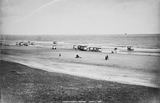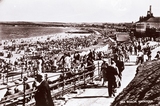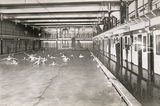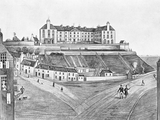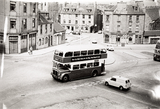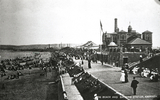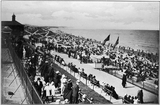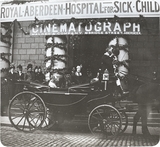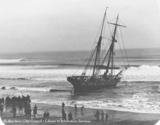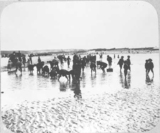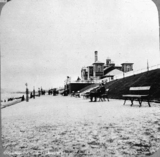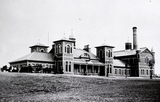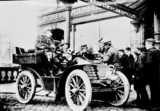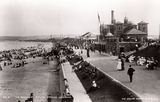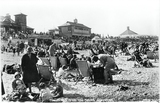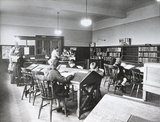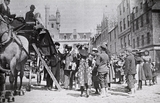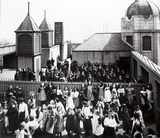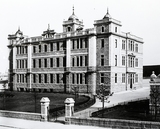|
Quick Search
|
Search Results
You searched for: More Like: 'Children paddling at the beach'
342 items
items as
Aberdeen Beach
45 A George Washington Wilson photograph (no. 4045) showing Aberdeen beach in the late 19th century.
Bathing machines (also called bathings huts) can be seen at the water's edge. These were drawn to and from the sea by horses, as can be seen in the image.
There were about 30 machines on the beach at any one time and male and female bathing areas were segregated.
In 1933 the horses were retired and the machines served as static changing huts until 1954. They were then kept in storage and later offered for public sale as mementos of a bygone bathing era. Aberdeen Sea Beach
51 The Promenade at Aberdeen Sea Beach, c. 1950 with the Beach Shelter and Beach Bathing Station in the background. Beach Bathing Station
99 The interior of the Beach Bathing Station, where generations of Aberdonians learnt to swim in the fresh water pool. The Bathing Station was designed by City Architect, John Rust, and opened on 13th July 1898. A distinctive red brick chimney dominated the beach skyline. The Bathing Station was eventually filled in and demolished, the door having finally closed to the public on 11th July 1972. Castlehill Barracks
106 A view of the southern aspect of the Castlehill in about 1850, with the Barracks featuring prominently. The Barracks replaced the Chapel of St. Ninian and an observatory erected in 1781. The foundation stone was laid on 24th June 1794 by the Marquis of Huntly and it was completed early in 1796, with accommodation for 600 men. The picture is interesting, as it shows the line of Hangman's Brae, which descended from the south west corner of the hill to Castle Lane and into Virginia Street. It was partly absorbed into the construction of Castle Terrace in 1864. The houses on the left of the illustration with the outside steps were incorporated into the first Hospital for Sick Children in 1877. Park Street
140 View of Park Street with an Aberdeen Corporation Bus and the Eastern Star pub visible. The pub occupied the corner of Park Street and East North Street.
The Aberdeen Pub Companion (1975) states that it was built in 1890 and that James Hill was the first licensee. It was familiarly known as Jimmy Hill's and was a popular local pub. It was demolished around 1960 to make way for the large roundabout at the foot of the Beach Boulevard.
(Many thanks to local historian A. G. Duthie for getting in touch and identifying the pub.) Aberdeen Beach and Bathing Station
189 Aberdeen Beach and Bathing Station. The Beach Bathing Station where generations of Aberdonians learnt to swim in the fresh water pool. The Bathing Station was designed by City Architect John Rust and opened on 13 July 1898. A distinctive red brick chimney dominated the beach skyline. The Bathing Station was eventually filled in and demolished, the door having finally closed to the public on the 11th July 1972. Plan of the Harbour of Aberdeen
292 Plan of the Harbour of Aberdeen with its alterations as proposed 1787 by Mr. Smeaton.
Royal visit by Princess Beatrice
315 A photograph showing Princess Beatrice at Aberdeen Music Hall to open a bazaar in aid of the Sick Children's Hospital.
The bazaar took place in the Music Hall on Saturday 29th and Sunday 30th October 1898. Princess Beatrice, then known as Princess Henry of Battenberg, opened the bazaar the day before on Friday 28th October.
The opening ceremony was covered in the Aberdeen Journal of 29th October 1898, page 5. The article states that Beatrice arrived by train at the Joint Station before travelling to the Music Hall from Guild Street by the horse drawn carriage that we can see here.
The route travelled and much of the surrounding area were specially decorated for the occasion. The various businesses and buildings along the route decorated their own premises and many of these decorations are described in the newspaper report.
The city gardeners Peter Harper of Duthie Park and Robert Walker of Victoria Park were tasked with creating floral displays. Harper decorated the interior of the Joint Station and the Music Hall, while Walker decorated the route between the two.
The special royal train arrived at the joint station a couple of minutes before its scheduled time of 12:15pm. Beatrice was greeted at the station by a large civic and military reception and crowds of onlookers.
The newspaper report indicates that travelling in the horse drawn carriage with Beatrice was Miss Minnie Cochrane and Lord William Cecil, both were royal courtiers. The man sat in the carriage is therefore most likely the latter.
Following the opening ceremony, Beatrice was entertained at a luncheon at the Palace Hotel by the directors of the Royal Aberdeen Hospital for Sick Children.
Beatrice and her party returned to Balmoral on a train leaving the station at 2:45pm.
The newspaper also tells us that Messrs. Walker & Company, cinematographers, Bridge Street, filmed the procession as it passed along the railway bridge on Guild Street. Assistant photographers with still cameras captured the rest of proceedings. This photograph was likely taken by one of these assistants.
A sign for Walker & Company can be seen hanging above the Music Hall entrance. This dates the image as belonging to this later royal visit by Princess Beatrice. She previously visited the city on 27th September 1883 to open an earlier bazaar for the Children's Hospital and to open the newly created Duthie Park 'The Queen', Aberdeen Beach, 1883
340 The coal ladden schooner, 'The Queen' driven ashore on Aberdeen Beach in March 1883, during a terrible gale. It was unable to make the crossing of the bar at the entrance to the harbour and a number of the crew, frozen and stiff with cold, were blown off the rigging and drowned in the night. Children catching shrimps at Aberdeen Sea Beach
341 Children catching shrimps at Aberdeen Sea Beach. Aberdeen Bathing Station
356 The Beach Bathing Station opened on 13th July 1898, replacing an earlier bathing establishment. This image shows the western, landward, side of the Victorian red brick building with its prominent chimney stack that stood 70 feet high.
At the time of opening the pool was described as the largest in Scotland. It measured 90 feet by 35 feet and 3 to 7 feet in depth. The pool was salt water up until 1958 before changing to freshwater.
Facilities included a water chute, a 9 foot diving board and a spring board at pool level.
Despite a renovation in 1964 its gradual deteriorating condition and decline in use led to its closure in July 1972 and the building was subsequently demolished. Gala and Heather Day in the Duthie Park
395 This Adelphi Series postcard shows the Gala Day taking place in Duthie Park on 21st August 1915.
The Gala in Duthie Park and the accompanying Heather Day were both organised to raise funds for the Aberdeen Royal Infirmary.
The Gala Day is one of largest events ever to take place at the park. It was estimated that between 25,000 and 26,000 people attended. Tickets cost 6 pence (6d) for general admission and 2s 6d for carriages or motor cars.
Within the park there was an elaborate programme of entertainment and refreshments organised. Details of the programme were published in a 32 page booklet prior to the event. Upwards of 1,300 people took part in the programme.
Gates to the park opened at 3pm and the event officially commence at 3pm with a grand military parade. Lieut-Colonel A. H. Leith of Glenkindie, Garrison Commander, and Lord Provost James Taggart "took the salute" opposite the Hygiea statue.
The Gala and Heather Day were organised by a distinct committee; Taggart was its president and Alexander Findlay, Superintendent of Cleansing, was its chairman. Councillor H. J. Gray was the secretary and treasurer and Mr John Lints was his assistant. There were also conveners and secretaries for various sub-committees concerned with aspects like entertainment and refreshments.
There was a wide range of entertainment organised for within the park including singing, dancing, gymnastic displays, musical drill, motor cycle gymkhana and bayonet fighting. Various platforms saw performances from acts such as a company lead by D. M. Kinghorn, pierrots directed by Minnie Mearns, Dan Williams, and W. A. Craig's operatic choir. Charles Soutar lead a 500 strong choir of children from the city's public schools.
Practically all naval and military units present in the city were represented at the event and individuals from many of them took part in the sporting competitions. The day also included a 5-a-side football and tug of war competition. Preliminary matches for these took place prior to the day at Pittodrie Park.
The Gala Day was filmed and this was later shown as part of a special programme at the Picture House on Union Street from the 25th of the month.
Over £500 was taken at the gates for the event. Entertainment and refreshments within further increased the figure raised.
Heather Day itself generated another £474. This involved over 1,500 vendors going around all parts of the city selling sprigs of the plant. The sale started on the afternoon of the Friday and continued all through Saturday. Entertainment venues throughout the city were also visited.
The vendors were primarily young women and members of organisations like the boys brigade. Stores present in all areas of the city were replenished from a central depot at 173a Union Street. This in turn was supplied by the cleansing department buildings in Poynernook Road, where the preceding week had seen 200,000 sprigs prepared for sale. Peterhead, Inverurie, Ellon and Banchory organised their own Heather Days for the same fund.
The sum taken from both the Gala and the Heather Day was estimated at considerably over £1,000.
See the report in the Aberdeen Journal, Monday 23rd August 1915 page 8, for further details about the occasion. The Pleasure Park, Aberdeen Beach
397 A postcard showing John Henry Iles' Pleasure Park in the 1930s. The park's esplanade site, south of Wellington Street (roughly where Amadeus nightclub/the Range and part of the Queen's Links carpark would later stand), was leased to Iles by the Council in 1929. Illes was an amusement entrepreneur originally from Manchester.
The park's biggest attraction, in all senses, was the Scenic Railway roller coaster shown here. Iles was involved in several amusement parks around Britain and during a visit to New York he obtained the European rights to the design of the latest roller coasters. He subsequently erected his Scenic Railway in Aberdeen in 1929.
The roller coaster rose to 100 feet in the air at its highest point and was popular with holiday makers and locals throughout the 1930s. The local press recorded 21,000 children, between 3 and 14 years of age, carried on the ride during a special children's day that was held on Saturday 20th August 1932.
Part of the message written on the back of this postcard by a young visitor to Aberdeen reads "This picture shows you the scenic railway which I have been on and liked very much".
The Scenic Railway was sadly badly damaged by fire on the night of 5th December 1940 and was consequently demolished. Other attractions of Iles' park included rides such as The Caterpillar, The Whip, Water Dodgems, and the Brooklyn Racers (petrol driven cars).
In the background of this image be seen the tower of St. Clements Church and a row of tenements, likely those on Wellington Street. Palace Hotel, Union Street
401 The main entrance to the Palace Hotel on Union Street. Children look on as a lady climbs onto a motor car. In the background can be seen the shop front of James Lorimer. The Palace Hotel, on Union Street, was built in 1874 for Messrs Pratt and Keith, milliners, who occupied the street level area, it operated as one of a chain of LNER hotels. It's upper stories were destroyed by fire 31 October 1941, with loss of life, and the building was entirely demolished after the war. Aberdeen Beach with the Beach Baths
404 An Adelphi Series postcard showing Aberdeen Beach with the Beach Baths building on the right.
Also known as the Beach Bathing Station, its fresh water pool was where generations of Aberdonians learnt to swim.
The Bathing Station was designed by City Architect John Rust and opened on 13 July 1898.
Its distinctive red brick chimney dominated the beach skyline.
The Bathing Station was eventually filled in and demolished, the door having finally closed to the public on the 11th July 1972. Aberdeen Beach from the south
406 Aberdeen Beach from the south. A crowded day on the beach. Note the roof of the Beach Ballrooom at the right of the photograph. Union Terrace and Gardens
412 A postcard image showing Union Terrace Gardens in the centre of Aberdeen.
There are a couple of notable features that might be able to help date the image: there is no bandstand present and the lower, central area in this image is still in the older lay-out with wide dividing paths.
The removal of the bandstand and change of lay-out may have been carried at around the same time. A minute from an Aberdeen Town Council meeting of 21st September 1931, detailing a recommendation from the Links and Parks Committee to the full Council, reads as follows:
"The Committee had before them a report by the Superintendent of the City Parks, in which he points out that he has had the bandstand in Union Terrace Gardens examined, that it is in a bad state of repair, and that he has been informed that the cost of repairing the worn-out parts would be almost equal to the cost of a new stand. He further states that the bandstand has not been used for some years, owing to the noise from the adjoining railway interfering with the performances, and suggests that the stand should be removed, the site and surrounding pathways levelled, covered with soil and sown with grass seed. If this were done, the playing area would be increased by 1,407 square yards, as shown coloured yellow on the plan herewith submitted, thereby giving greater facilities to the large number of children who frequent the Gardens.
"The Committee approved of the report, and beg to recommend that the Council should grant authority to the Superintendent of Parks to have the bandstand removed and the other work carried out as proposed." (Minutes and Proceedings of Town Council, City of Aberdeen, 1930-1931, page 660.
The full Council approved this recommendation from the Links and Parks Committee. In light of this information, the image may date from relatively shortly after September 1931. After the bandstand has been removed but before the ground had been leveled and sown as a single larger grass lawn. Children's library, Woodside
421 The Children's section downstairs in Woodside Library, Clifton Road. A 'wagonette' travelling between Castle Street and the beach
429 A 'wagonette' travelled between Castle Street and the sea beach taking people down to enjoy the bracing sea air. Note the bare foot children in the foreground. Frederick Street Primary School roof playground
453 A photograph showing school children on the roof top playground of Frederick Street Primary School in around 1907.
This was one of very few such playgrounds in the city, perhaps one of only two. The Central School on Schoolhill also had a comparable, roof-top playground for at least some of its history.
Frederick Street School opened in 1905 and had a role of 332 infants and 764 senior/junior pupils. The unusual, elevated playground measured 750 square feet. |



